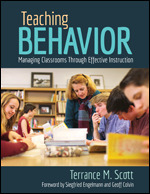Teaching Behavior
Managing Classrooms Through Effective Instruction
- Terrance M. Scott - SRI Education, Center for Learning and Development
Foreword by Siegfried Engelmann and Geoff Colvin
The key to effective classroom management starts with instruction
Every teacher knows that the perfect lesson plan is useless without effective classroom management. But what’s the best way to foster student engagement, differentiate instruction, handle disruptive students, and promote positive behavior? The answer is in how you teach.
Teaching Behavior goes well beyond setting classroom rules, communicating consequences, and providing the usual tips on engaging students and building relationships. It draws on the most current evidence-based practices and rich, real-world examples to get to the heart of effective teaching. A national expert in behavior and special education, Terry Scott shares clear, detailed and proven instructional strategies to maximize student success. Teaching Behavior is ideal as a teacher guide or textbook, offering
- New insights on why instruction is the foundation for all student behavior
- Practical tools for managing all types of students and classrooms, including the most challenging
- Self-assessment checklists and discussion questions for teacher book-study groups
Wherever you are in your teaching career, Teaching Behavior will give you the innovative, day-to-day tools to conquer the toughest behavior challenges and make your classroom more effective and fun — for you and your students.
"Terry Scott provides numerous suggestions for educators who want to teach students ways to address their behavior in order to have a positive impact not only on the students’ conduct but ultimately on their academic success."
Marcia B. Imbeau, Ph.D., Professor
University of Arkansas
“Classroom management is, was, and always will be, of concern to educations. Teaching Behavior is a great springboard for focused dialogue between experienced and beginning teachers on this topic.”
Sandra Moore, ELA Teacher
Coupeville High School
Supplements
"Classroom management is, was, and always will be of concern to educators. Teaching Behavior is a great springboard for focused dialogue between experienced and beginning teachers on this topic."
"Every teacher has encountered students who have outbursts that cause the teacher to wonder about the best strategy for dealing with their conduct while trying to prevent the outbursts in the future. Terry Scott provides numerous suggestions for educators who want to teach students ways to address their behavior in order to have a positive impact not only on the students’ conduct but ultimately on their academic success. Teachers will appreciate the practical examples and detailed guidance for addressing a variety of challenges."
"Terrance Scott's extensive history and experience show a clear understanding of behavior in the classroom."

